
A forest garden island grows
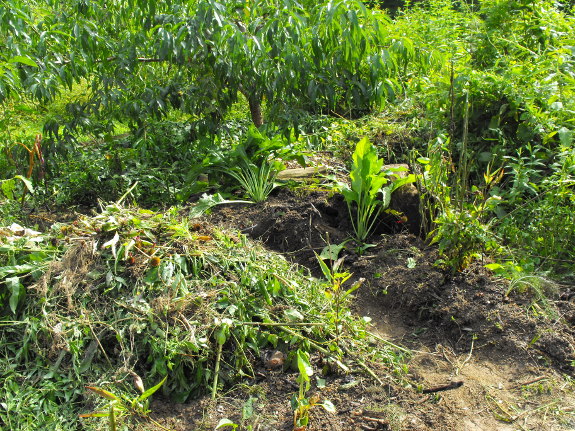
I started my most
successful forest garden island very simply. I planted
the tree in a raised bed, then dumped weeds around the bed's edges for
three years.
The mounds of weeds rotted down to expand the original raised bed,
creating rich dirt that extended beyond the tree's canopy. I highly
recommend this method since it requires you to maintain your focus on
the centerpiece tree, giving it a few years to get established before
the tree has to compete with anyone else.
The photo above shows the
three year old peach tree in August 2009. At this point, my
well established peach was ready to handle understory plants, so I
transplanted comfrey and bee balm into the partial shade beneath the
peach's canopy, and fennel, echinacea, rhubarb, and Egyptian onions in
the sun.
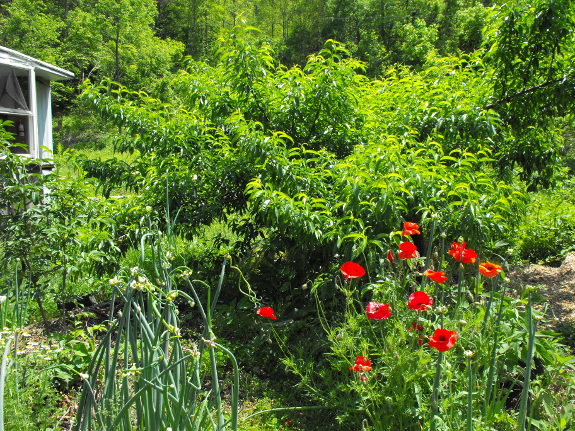
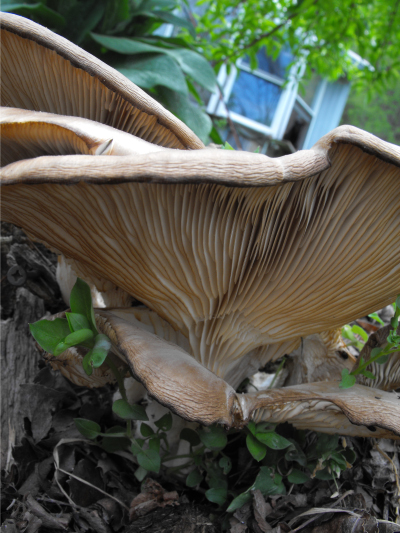 May
of the next year, the forest garden island was in full swing. In less successful
forest garden islands, I had planted comfrey under younger peach trees
in poor soil, and the comfrey
stole nitrogen from the tree. But this more
established peach had no problem shading the comfrey enough that the
understory plant behaved.
May
of the next year, the forest garden island was in full swing. In less successful
forest garden islands, I had planted comfrey under younger peach trees
in poor soil, and the comfrey
stole nitrogen from the tree. But this more
established peach had no problem shading the comfrey enough that the
understory plant behaved.
You'll notice that
fennel, echinacea, and rhubarb have disappeared --- these plants didn't
like being transplanted in the summer heat. However, the Egyptian
onions were thrilled with their new home and thrived even during my
summer neglect.
That spring, I seeded
poppies amid the Egyptian onions, which added a lot of beauty, but
won't be repeated. I love puttering in my forest garden islands
in the winter, but in the 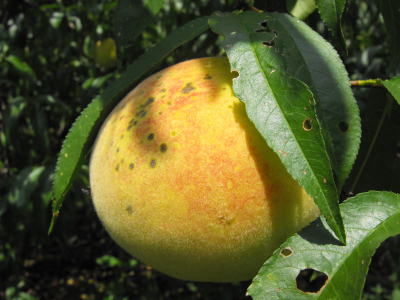 summer I'm too busy in the
vegetable garden to give them any care. Since
annuals tend to require bare ground, which has to be weeded, they're
out of the running as forest garden plants.
summer I'm too busy in the
vegetable garden to give them any care. Since
annuals tend to require bare ground, which has to be weeded, they're
out of the running as forest garden plants.
This second year of the
forest garden island was when our peach started producing --- over half
a bushel that summer. Meanwhile the
ecology of the island seemed to come into its own, attracting birds,
insects, and wild mushrooms.
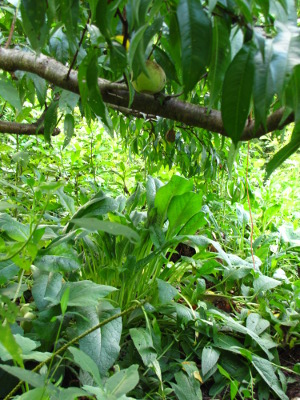
Last year was the third
year of forest garden experimentation. The peach
had achieved its mature size and was starting to shade out the comfrey
and bee balm closest to the trunk. That allowed me to add another
type of understory plant --- shade lovers. I transplanted ramps right around the tree's
trunk and daffodils helter skelter throughout
the island. Both of these plants are early spring ephemerals,
which are active in the spring before the tree canopy shades them out,
then die back when summer arrives.
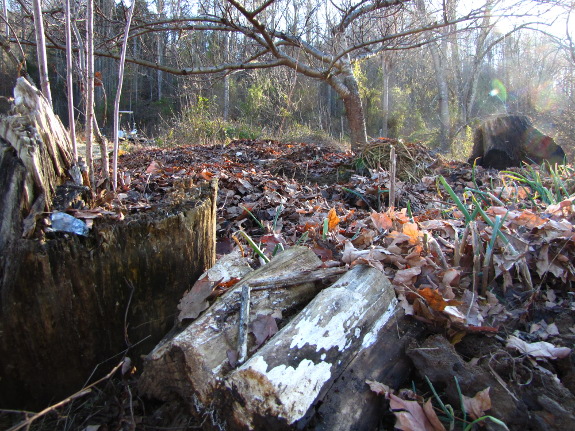
Where will the island go
from here? I'm experimenting with more shade-loving species this
spring --- goldenseal
and ginseng.
Meanwhile, if I get around to it, I plan to transplant some flowering
perennials into the sunny zone --- probably bee balm, echinacea, and
fennel, since I have them around in excess.
A wild elderberry sprang
up at the edge of the forest garden island a few years ago, and I left
it alone since it seemed to be far enough away that it doesn't compete
with the peach. 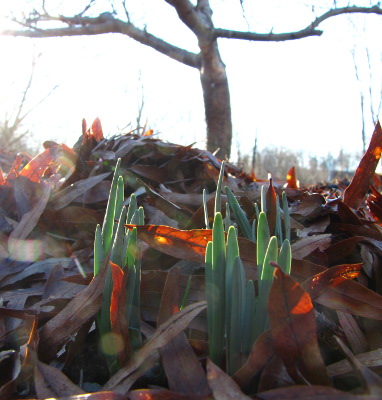 Pollinators seem to love the
flowers, and the birds enjoy the fruits. (I know elderberries are
edible for humans too, but I'm not enough in love with the taste that I
feel the need to fight off the birds, who really love the taste.)
Pollinators seem to love the
flowers, and the birds enjoy the fruits. (I know elderberries are
edible for humans too, but I'm not enough in love with the taste that I
feel the need to fight off the birds, who really love the taste.)
The island has stopped
expanding since the peach has achieved its final size, and I can feel
the ecosystem starting to reach a steady state. Annual
maintenance is now about the same as it would be for any other fruit
tree, but I
suspect the tree is healthier for the diverse ecosystem under and
around its canopy. Plus, we get to enjoy a bit of beauty right
outside the kitchen window. This is one of our most successful
permaculture experiments, and I highly recommend you try it out around
your own fruit trees.
Want more in-depth information? Browse through our books.
Or explore more posts by date or by subject.
About us: Anna Hess and Mark Hamilton spent over a decade living self-sufficiently in the mountains of Virginia before moving north to start over from scratch in the foothills of Ohio. They've experimented with permaculture, no-till gardening, trailersteading, home-based microbusinesses and much more, writing about their adventures in both blogs and books.
Want to be notified when new comments are posted on this page? Click on the RSS button after you add a comment to subscribe to the comment feed, or simply check the box beside "email replies to me" while writing your comment.

I was actually just discussing that with Mark to see what he thought. I felt the post was going to lose a lot of people's interest because of its length, so I bolded the highlights. Not sure if the strategy worked or not....
Gotta go get the golf cart unstuck before the driveway thaws, then I'll email you.
How can you plant a raised bed around a tree without burying the crown and killing the tree?
BTW - I really enjoy your blog.